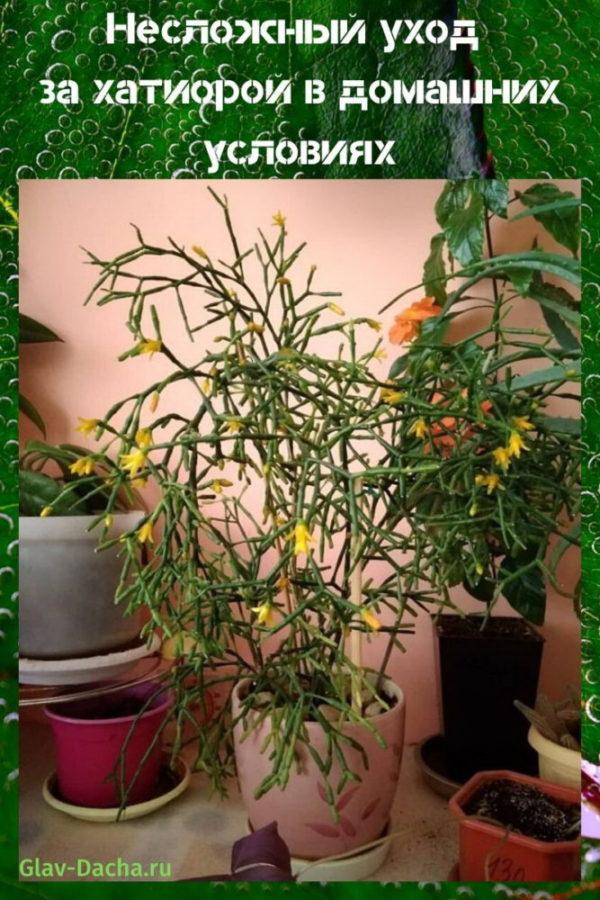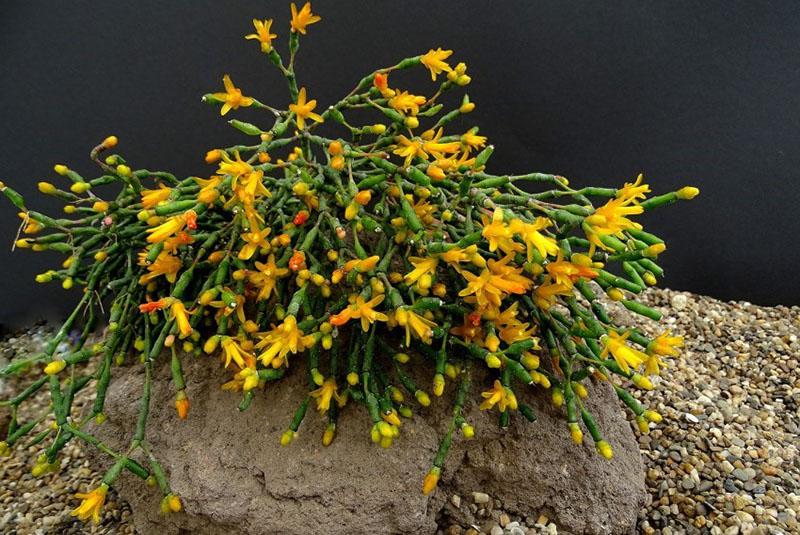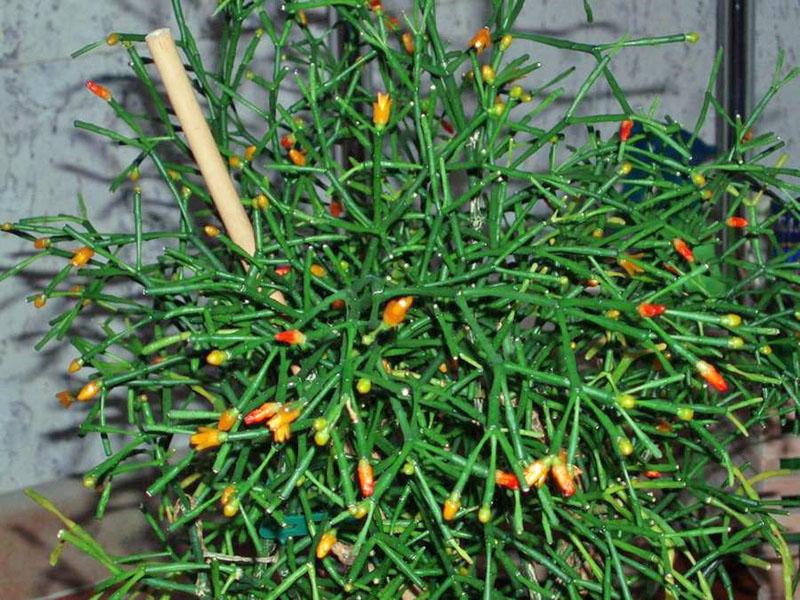Simple hatiora care at home
 Hatiora is an evergreen succulent plant from the epiphytic cactus family, it is a small shrub with straight and branching jointed shoots. As with many plants of the cactus family, caring for a hatiora at home is simple, but has a number of features.
Hatiora is an evergreen succulent plant from the epiphytic cactus family, it is a small shrub with straight and branching jointed shoots. As with many plants of the cactus family, caring for a hatiora at home is simple, but has a number of features.

What does home care for a hatiora include?
 Since the shrub has a spreading crown, the main condition for its successful growth is the availability of sufficient space in a flowerpot or pot. Hatiora's shoots are very fragile, so you need to take care of supports for additional stability of the central stems and branches that are too large, which can break under their own weight.
Since the shrub has a spreading crown, the main condition for its successful growth is the availability of sufficient space in a flowerpot or pot. Hatiora's shoots are very fragile, so you need to take care of supports for additional stability of the central stems and branches that are too large, which can break under their own weight.
Microclimate and lighting
 The indoor flower hathiora is photophilous, but requires diffused lighting, since direct sunlight can cause burns on green shoots. In insufficient light, plant growth slows down. The temperature regime is quite variable from + 18˚C to + 27˚C, but depends on the change of seasons. In this case, sharp temperature changes and drafts should be avoided. When cooled to a temperature of + 8 ° C, frostbite of the roots and death of the whole plant is possible.
The indoor flower hathiora is photophilous, but requires diffused lighting, since direct sunlight can cause burns on green shoots. In insufficient light, plant growth slows down. The temperature regime is quite variable from + 18˚C to + 27˚C, but depends on the change of seasons. In this case, sharp temperature changes and drafts should be avoided. When cooled to a temperature of + 8 ° C, frostbite of the roots and death of the whole plant is possible.
Like all tropical inhabitants, the hatiora loves high air humidity, but has a negative attitude to waterlogging of the soil. On hot summer days, the plant must be sprayed with a spray bottle, and watered only when the soil is completely dry. In winter, the amount of watering should be minimized, about 1-2 times a month. It is recommended to settle water for irrigation during the day, since fresh water is too hard and can change the pH of the soil.
In winter, temperatures should be slightly lower than in summer. Seasonal temperature changes are important for kidney formation.
Some flower growers, in order to bring the care of the hatiora at home to the natural conditions of its habitat, place a pot with a plant in a pallet with wet expanded clay.
Soil and fertilizers
The roots of the hatior are very weak and are located in the upper layer of the soil, therefore, it is necessary to choose a slightly acidic soil with a breathable light structure. A mixture of peat, coarse sand, sod and leafy soil, taken in a ratio of 1: 1: 1: 2. Charcoal and tree bark are added to the finished substrate.
Before drawing up the soil mixture, the sand must be well calcined in the oven for 1 hour or filled with a pink solution of potassium permanganate.
As a top dressing, mineral nitrogenous fertilizers are used containing such basic trace elements as nitrogen, phosphorus and potassium in a ratio of 1: 2: 3. Fertilizers containing calcium are not suitable for hatiora, as this trace element alkalizes the soil.
Hatiora pruning and transplanting
 This plant does not need decorative pruning. Chaotically overgrown shoots and a slightly disheveled look of the bush are an exotic highlight of the hatiora. At the same time, one should not forget about hygienic pruning - removal of damaged and yellowed segments. This is done by hand without the use of sharp cutting tools.The segments are carefully unscrewed from the branch without injuring the entire shoot.
This plant does not need decorative pruning. Chaotically overgrown shoots and a slightly disheveled look of the bush are an exotic highlight of the hatiora. At the same time, one should not forget about hygienic pruning - removal of damaged and yellowed segments. This is done by hand without the use of sharp cutting tools.The segments are carefully unscrewed from the branch without injuring the entire shoot.
Hatiory transplantation is usually carried out in the spring during the period of intense vegetative growth every 2-3 years. The size of the old and new pot should not be very different, otherwise it will slow down growth and negatively affect flowering. The new root system takes a very long time to regenerate, so damage to the earthy coma must be minimized. The bush is simply gently transferred into a large container, and the voids are filled with soil mixture.
If, during transplanting, the plant is deepened more deeply into the soil, then the lower shoots will begin to rot, which will lead to the death of the entire plant.
Reproduction methods
 In indoor conditions, the hatiora blooms in winter, therefore it is recommended to propagate the plant in early spring after the flowering period.
In indoor conditions, the hatiora blooms in winter, therefore it is recommended to propagate the plant in early spring after the flowering period.
Reproduction of hatiors and care for new plants depend on the breeding method:
- Cutting is the fastest and most convenient way. To do this, twisting, break off a fragment of the shoot containing 2-3 segments. The twigs are dried for several hours and rooted in a moist substrate (peat and sand in equal proportions). New plants are watered only in a pan when the soil is completely dry. To accelerate the formation of new roots, you can use stimulants, for example, "Kornevin".
- Graft. As a rootstock, a prickly pereskiy is used, from which the branched part is removed and the stem is split. A branch of a hatiora, consisting of 2-3 segments, is inserted into the cleft and fixed with a plaster. The patch is removed after the start of scion growth.
- Seed reproduction. From the flowers, fruits are formed in the form of yellow or white berries, after they ripen, seeds can be collected. The seeds are carefully sown in a loose, moist substrate. The container is covered with glass. As soon as shoots appear, the glass is immediately removed. When the seedlings grow 3 cm in height, they are dived into a separate container.
Seed propagation is usually used for breeding purposes, since at home it is too long and unnecessarily complicated process.
Hatiora bloom
 Flowering begins in December and continues until early spring. The buds are usually laid at the ends of the youngest areoles. The life span of each flower is several days, but due to the uneven appearance of flowers, the plant blooms for about 2-3 months.
Flowering begins in December and continues until early spring. The buds are usually laid at the ends of the youngest areoles. The life span of each flower is several days, but due to the uneven appearance of flowers, the plant blooms for about 2-3 months.
Caring for a hatiora at home during flowering has its own characteristics. So, the recommended air temperature should not exceed 19˚С. In order for flowering to be as abundant as possible, it is necessary to use organic fertilizers... It is important not to allow the soil to dry out, otherwise the plant will drop flowers and buds, but it is also impossible to overmoisten the soil.
During flowering, it is not recommended to rearrange the pot or turn it, otherwise the hatiora may shed flowers or not bloom for a long time.
Novice flower growers often ask themselves - why does the hatiora not bloom? There may be several reasons for the answer to this question:
- lack of nutrients in the soil - the plant has not been transplanted for a long time or fertilized little in the spring;
- too high a temperature in winter;
- due to non-compliance with the seasonal temperature change, the plant did not form buds;
- the presence of diseases and pests.
Diseases and pests
 Many inexperienced flower growers are wondering how to care for a hatiora, already in the presence of certain problems. So, frequent and abundant watering can cause the spread of a bacterial or fungal infection.
Many inexperienced flower growers are wondering how to care for a hatiora, already in the presence of certain problems. So, frequent and abundant watering can cause the spread of a bacterial or fungal infection.
Bacterial foci of infection appear on the shoots in the form of loose soft areas covered with a viscous substance. A fungal infection can manifest itself in the form of mold plaque, the shoots become thinner, become colorless, gray. In this case, the damaged segments must be removed. Move the flower to a warmer place and temporarily stop watering.
In difficult cases, it is necessary to use antifungal drugs. If most of the plant is infected, then a healthy portion is separated from the mother bush. Then it is transplanted by grafting.
 Spider mites, scale insects and mealybugs often parasitize the hathyor. These insects are visible on the shoots and feed on the sap of the plant. To combat them, insecticidal agents are used, for example, "Aktara", "Mospilan", "Fitoverm", etc.
Spider mites, scale insects and mealybugs often parasitize the hathyor. These insects are visible on the shoots and feed on the sap of the plant. To combat them, insecticidal agents are used, for example, "Aktara", "Mospilan", "Fitoverm", etc.
If a bacterial, fungal or parasitic infection is detected, the hathyor must be urgently isolated from other indoor plants!
With insufficient watering or high dryness of the air, the shoots of the plant shrivel and wither. The appearance of a large number of light spots on the shoots signals sunburn. In this case, the plant must be darkened.
The slow growth of the hathiora and weak branching indicate a lack of trace elements in the soil. The reason for this can be not only insufficient fertilization of the flower, but also watering with hard water. The initial use of unbalanced soil when replanting will slow down plant growth.